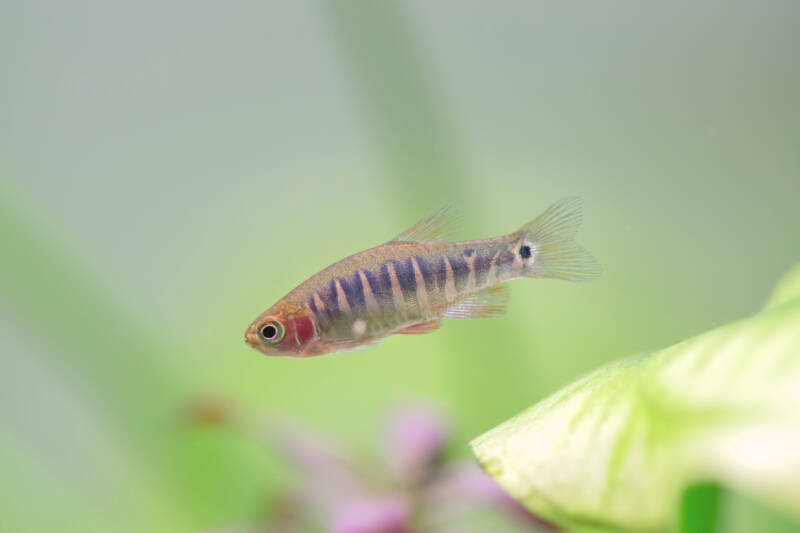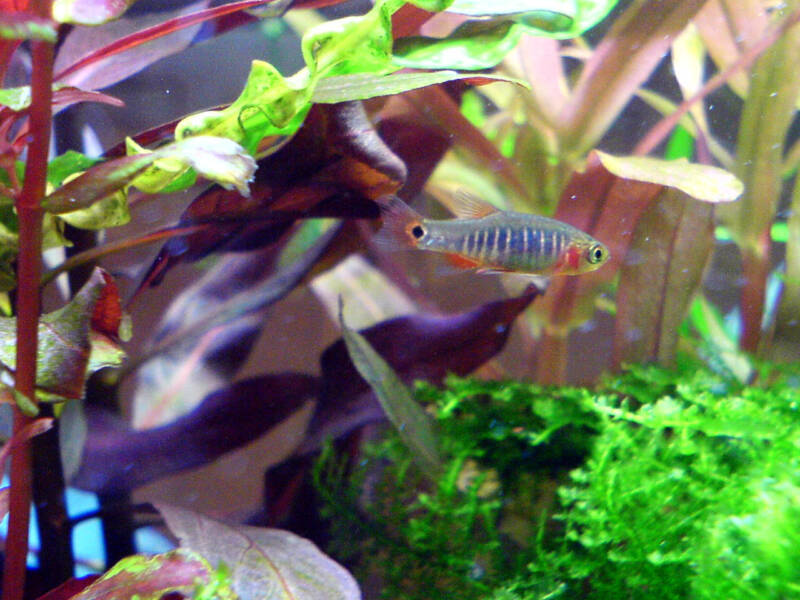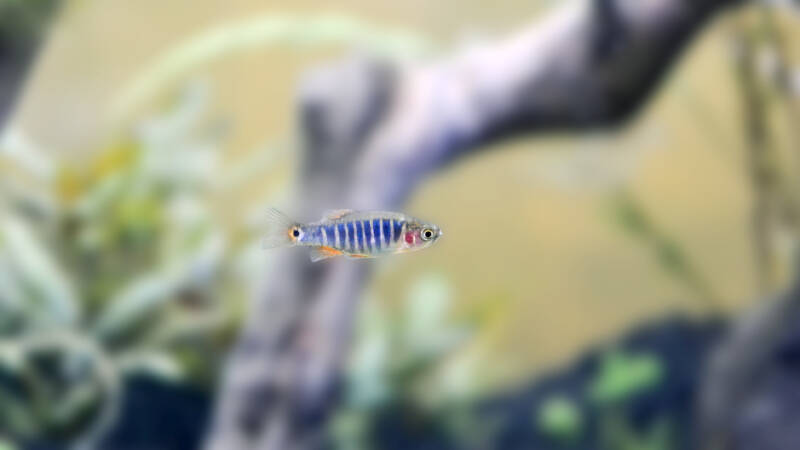The emerald dwarf rasbora (Microrasbora erythromicron) is a diminutive, brightly colored freshwater fish that hails from a mountain lake in Myanmar.

Although this fish is commonly referred to as a rasbora, it has more similarities to the danio fish species.
Thus, the nomenclature may be somewhat confusing as you will also find it under the scientific name (Celestichthys erythromicron).
This fish is an excellent choice for a cool water aquarium. Not only is it beautiful individually, but this shoaling fish also makes for an impressive group display.
Add in their friendly temperament, and you can feel comfortable keeping this fish in a single species or community tank.

Read on for more information on the care and breeding of this tiny fish.
At a Glance
| Tank Size: | 10 gallons |
| Group Size: | 6 or more |
| Water Temperature: | 68 to 76°F (20 to 24°C) |
| pH: | 7.0 to 8.0 |
| Hardness: | 2 to 10 dKH |
| Lifespan: | 3 to 5 years |
| Breeding: | Egg scatterer |
| Adult Size: | 1 to 1.5 inches (2.5 to 4 cm) |
| Usual Place in the Tank: | Middle to bottom |
[toc]
Natural Habitat
Myanmar’s Lake Inle is the emerald dwarf rasbora’s home. This lake is almost 14 miles long and six miles wide (22 by 10 km) and situated in a mountain valley at an elevation of 2,953 feet (900 m).
It is one of Myanmar’s popular tourist destinations known for its beautiful floating gardens, fresh local fish cuisine, and it is home to the Intha people, who have fished the lake for generations using their unique rowing techniques.
The water in this lake is clear, heavily vegetated, and shallow, reaching a depth of five to 10 feet (1.5 to 3 meters). The pH is alkaline and in the range of 7.8 to 8.
The emerald dwarf rasbora is one of 17 endemic species of fish.
Increased pollution from the tourist trade, sewage from hotels and homes, and pesticide use threaten its environment.
In addition, deforestation of the surrounding hills has led to runoff and sediment deposited in the lake, reducing the water level significantly.
Appearance and Biology
The emerald dwarf rasbora has a long, thin body shape, the base of which is colored pink or orange.Their copper-colored head features large eyes.
From behind the gills to the base of the tail, its body is covered in approximately 15 thick stripes that can range in color from emerald green to blue.
At the base of their tail, there is a large, dark dot rimmed in copper. This eye-shaped feature serves as mimicry to dissuade predators.
How can I tell if my fish is a male or female?

There are subtle elements of sexual dimorphism with this species.
Males tend to be slightly smaller and more vibrantly colored. Their fins can appear red or orange, whereas females’ fins are clear.
Size
The adult size of an emerald dwarf rasbora is 1 to 1.5 inches (2.5 to 4 cm) in length.
When purchased, they may be as tiny as half an inch, but they quickly grow to adult length.
Lifespan
This fish has a long lifespan for a small fish and can live anywhere from three to five years.
Naturally, the better care you provide for your fish, the longer the potential lifespan will be. Keeping your aquarium water clean is one important factor to promote a long and healthy life for this fish.
Behavior
If you are looking for a peaceful fish for a single species or a community tank, the emerald dwarf rasbora will not disappoint.
This fish has a gentle nature and loves to shoal with others of its kind. When in a larger group, this fish is more comfortable, less stressed, and very lively.
Although they enjoy hanging out with others of their kind, they do not always stick with the group.
They are curious fish that will venture out from time to time to explore other tank areas.
Are emerald dwarf rasboras fin nippers?
Not typically. You may see some aggression between competing males, but it does not often result in serious injury.
They will leave other species in the tank alone, and keeping larger groups of emerald dwarf rasboras can help to diffuse any aggression.
How many per gallon?
With its small size, the emerald dwarf rasbora is suitable for a nano tank; however, we recommend a minimum tank size of 10 gallons. This will allow a nice group of about six fish.
Remember that this is a maximum stocking level, and with fish like these that love to swim, you may want to consider a larger tank, especially if you are planning to add other species.
Tank Setup
The ideal tank setup is one that closely replicates the emerald dwarf rasbora’s natural habitat. As we mentioned earlier, they are accustomed to waters that are heavy in vegetation, clear as a result, and on the alkaline side.
Mimicking their habitat in an aquarium setting will go a long way toward making your fish comfortable.
Decorations
Go with either darkly colored backgrounds or live plants to bring out the color of this fish. Line the bottom with a dark-colored, soft sand substrate.
Because their natural habitat features rich plant life, consider both submerged and floating aquarium plants to provide plenty of hiding places.
When arranging your tank, leave plenty of open space to allow your fish adequate swimming space.
Water Conditions
Keep the temperature on the cool side, in the range of 68 to 76 degrees Fahrenheit (20 to 24 degrees C).
The pH level should stay slightly alkaline, around 7.0 to 8.0, and the hardness should be between 2 to 10 dKH. Change out a portion of the water regularly.
Equipment
These fish prefer clear water, so install a reliable filter to keep the water clean and prevent the buildup of waste material, ammonia, and nitrates.
Consider investing in testing kits to make sure the water quality is optimal for your fish.
Tank Mates
Naturally, because the emerald dwarf rasbora is a shoaling species, the best tank mates you can select are more emerald dwarves.
These fish are tiny and have a very peaceful nature, so take care when selecting other species to pair them with in a community tank. While your rasboras will not bother the other fish, any larger or more aggressive fish may assume they are food.
One fun idea is to select species that are native or endemic to Lake Inle to pair with your emerald dwarf.
That way, you can be assured that all species will tolerate the same water conditions and tank setup. Plus, you have a miniature representation of Lake Inle’s habitat in your home.
Consider the following to pair with your emerald dwarf rasbora:
- More emerald dwarf rasboras
- Small barbs
- Devarios
- Freshwater snails
- Fish native or endemic to Lake Inle or Myanmar
- Sawbwa barb (Sawbwa resplendens)
- Red dwarf rasbora (Microrasbora rubescens)
- Lake Inle danio (Devario auropurpureus)
- Celestial pearl danio (Danio margaritatus).
Avoid the following:
- Larger, more aggressive fish
- Tropical fish or those requiring warm water.
Food and Diet
The emerald dwarf rasbora is an omnivorous fish. In the wild, they prefer a protein-rich diet that includes insects.
However, they will eat what is available, including plant matter and algae.
In your aquarium, the base of your rasbora’s diet should be a high-quality commercial flake or pellet that is the appropriate size for this small fish.
Supplement with live or frozen foods, including brine shrimp, bloodworms, mosquito larvae, and daphnia. Small algae wafers will help satisfy their need for vegetable matter.
High-quality food and a well-rounded diet will help keep your fish’s color bright. It will also go toward extending their lifespan, reducing stress, and promoting breeding.
Breeding
Emerald dwarf rasboras are an egg scattering species. If your fish are of breeding age, they will be about an inch or more in length.
This species does not provide any parental care after spawning. The most important thing is to set up a separate breeding tank to allow the fry to hatch and develop.
Setting up a Breeding Tank
The breeding tank should have cycled water with the same parameters as the community tank. Change out small amounts of the water each day to keep the water clean.
Add a spawning mop, java moss, or leafy plants. Plan on an air stone to keep the water aerated and a sponge filter, which will allow the water to be filtered without the danger of sucking in one of the fry.
Spawning
Condition your fish with high protein foods for about a week before spawning. When the female is ready, she will scatter 30 or so eggs, which the male will fertilize.
Once this is complete, you can remove the parents to allow the eggs to hatch.
Caring for the Fry
The eggs should hatch within three days. The egg sacs will provide all the nutrition that the fry need for the first four days. After that, the fry become free-swimming.
At first, feed them infusoria or liquid fry food. Once they are large enough, you can switch to baby brine shrimp.
Let the fry continue to grow in the breeding tank for six to eight weeks. Once they are larger in size than their parents’ mouths, then it is safe to introduce the young fish into the community tank.
Hardiness
The emerald dwarf rasbora is a hardy fish, but as with many freshwater fish, it is susceptible to common tank diseases.
These diseases can occur more frequently in tanks with poor water conditions or when fish are continuously stressed.
The most common diseases seen with the emerald dwarf are ich, flukes, and swim bladder disease.
It is worth your time to read up on these ailments and learn to recognize the signs that your fish may be infected. If you confirm or suspect an infection, quickly isolate the fish to avoid spreading the disease to others in the tank.
Correct any water conditions in the tank that may contribute to your fish’s infection. Treat the disease with the appropriate in-water medication.
Closing Thoughts
The emerald dwarf rasbora is a tiny fish with a docile personality.When placed in a well-planted tank with a good number of its own kind, this species is lively and is sure to bring plenty of visual interest.
While a hardy species, this fish does best with a stable environment and very clean water.
Plan on using a good quality filter and testing the water regularly to keep your tank the best it can be.
Do you keep your emerald dwarf rasboras in a single species tank or a community tank?
Which smaller species do you prefer to pair them with?
We would love to hear from you below!
